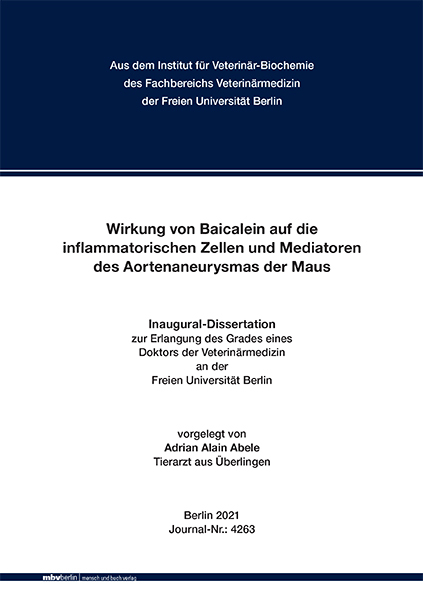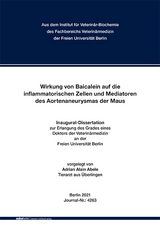Wirkung von Baicalein auf inflammatorische Zellen und Mediatoren des Aortenaneurysmas der Maus
Seiten
2021
|
1. Aufl.
Mensch & Buch (Verlag)
978-3-96729-132-2 (ISBN)
Mensch & Buch (Verlag)
978-3-96729-132-2 (ISBN)
- Keine Verlagsinformationen verfügbar
- Artikel merken
The effect of Baicalein on inflammatory cells and mediators in aortic aneurysm of mice
An abdominal aortic aneurysm (AAA) is defined as a pathological focal dilation of the abdominal aorta. Over 70 per cent of human patients die after a rupture of abdominal aortic aneurysm. This fact shows how important it is to explore the inflammatory development of aortic aneurysms. Nevertheless, the exact pathophysiological mechanisms are not revealed. The aim of this project was to investigate the effect of the anti-oxidative substance Baicalein on aortic aneurysm formation and the inflammation in a mouse model. Also the better understanding of the inflammatory pathway on development of aortic aneurysms should be explored.
The established Angiotensin II induced ApoE-/- -Mouse Model was used. During 4 weeks, 1500 ng/kg/min Angiotensin II was infused via an implanted osmotic pump (ALZET Modell 2004). Animals were classified in 4 groups. Group NaCl BAI- and NaCl BAI+ (n=10) had a saline infusion, Group Ang II BAI- and Ang II BAI+ (n= 30) were perfused with angiotensin II. The Groups NaCl BAI+ and Ang II BAI+ additionally received 1,5 mg/kg/day Baicalein via intraperitoneal injection. The aortic diameter, the peak systolic velocity and the mean velocity were measured weekly through the use of a duplex sonographer. After 4 weeks, the mice were sacrificed and the aortas were dissected. The aortas were stained with histological and immunohistochemical methods to locate the spread of immunological cells, apoptotic cells and the presence of inflammasome components in the aortic wall. Also the degeneration of the media (Grading 0-III) was staged via histological review.
There was no significant effect on mortality, diameter development and the incidence of aortic aneurysms with 30 percent in the verum-group in response to the injection of 1,5 mg/kg/day Baicalein. In addition, Baicalein treatment seems to be associated with the decrease of mortality and incidence of AAAs. Moreover, this dose did not change the presence and distribution patterns of inflammasoms in the aortic wall. Analyses of the medial degeneration seem to show a reduction through Baicalein.
The findings of this study in addition with the inhibition of AAA incidence and the decrease of AAA diameters of other investigations indicate that Baicalein might have an effect on the development of AAA. Abdominelle Aortenaneurysmen (AAA) sind eine krankhafte Aufweitung der Aorta, die einen potentiell letalen Verlauf haben und im Falle einer Ruptur mit einer Letalität von über 70 % einhergehen. Obwohl bekannt ist, dass inflammatorische Prozesse eine zentrale Rolle bei der Entstehung und Progression von Aortenaneurysmen einzunehmen scheinen, ist die genaue Pathophysiologie weiterhin unbekannt. Ziel dieses Projektes war es, im Tiermodell den Effekt des anti-oxidativen therapeutischen Wirkstoffes Baicalein auf das AAA und die Inflammation zu untersuchen sowie den Einfluss einzelner inflammatorischer Signalwege bei der Entstehung des AAAs besser zu verstehen.
Als Modell diente das etablierte AAA-Mausmodell, bei dem ApoE-/--Mäusen durch eine subkutan implantierte osmotische Pumpe (ALZET Modell 2004) über 4 Wochen Angiotensin II (1500 ng/kg/min) appliziert wird. Von den vier verwendeten Tiergruppen erhielten die Gruppen NaCl BAI- und NaCl BAI+ (n=10) physiologische Kochsalzlösung während die Tiergruppen Ang II BAI- und Ang II BAI+ (n= 30) Angiotensin II appliziert bekamen. Die Gruppen NaCl BAI+ und Ang II BAI+ bekamen zusätzlich täglich Baicalein (i.p. 1,5 mg/kg/Tag). Der Aorten-Diameter, die mittlere Fließgeschwindigkeit und der durchschnittliche systolische Spitzenfluss wurden wöchentlich duplexsonographisch gemessen. Nach dem Ende der Experimente wurde die Aorta entnommen, um anhand histologischer Färbungen die Mediadegeneration zu quantifizieren (Grad 0-III). Mittels histologischer und immunhistochemischer Färbungen erfolgte der Nachweis von Immunzellen sowie der Präsenz weiterer inflammatorischer Proteine in der Aortenwand. Zusätzlich wurde der Nachweis von apoptotischen Zellen im Aneurysma der Versuchstiere erbracht.
Die Baicalein-Therapie hatte keinen signifikanten Einfluss auf die Gesamtmortalität, die Aneurysma-spezifische Mortalität, die Diameterentwicklung und die bei 30 Prozent liegende Inzidenz von Aneurysmen in der Verumgruppe. Die vorliegende Arbeit zeigte, dass bei einer Dosis von 1,5 mg/kg/Tag Baicalein keine signifikanten Effekte auf die Präsenz von inflammatorischen Proteinen im Aneurysma erkennbar sind. Trotzdem ist eine tendenzielle Abnahme bei der Inzidenz und der Aneurysma-spezifischen Mortalität ersichtlich. Zusätzlich deutet sich eine Wirkung von BAI auf die Degeneration der Media an.
In Verbindung mit der Abnahme der AAA-Inzidenz und der Verringerung des AAA-Diameters in anderen Arbeiten weisen die Ergebnisse dieser Arbeit auf die Wirkung von Baicalein auf die AAA-Entwicklung hin.
An abdominal aortic aneurysm (AAA) is defined as a pathological focal dilation of the abdominal aorta. Over 70 per cent of human patients die after a rupture of abdominal aortic aneurysm. This fact shows how important it is to explore the inflammatory development of aortic aneurysms. Nevertheless, the exact pathophysiological mechanisms are not revealed. The aim of this project was to investigate the effect of the anti-oxidative substance Baicalein on aortic aneurysm formation and the inflammation in a mouse model. Also the better understanding of the inflammatory pathway on development of aortic aneurysms should be explored.
The established Angiotensin II induced ApoE-/- -Mouse Model was used. During 4 weeks, 1500 ng/kg/min Angiotensin II was infused via an implanted osmotic pump (ALZET Modell 2004). Animals were classified in 4 groups. Group NaCl BAI- and NaCl BAI+ (n=10) had a saline infusion, Group Ang II BAI- and Ang II BAI+ (n= 30) were perfused with angiotensin II. The Groups NaCl BAI+ and Ang II BAI+ additionally received 1,5 mg/kg/day Baicalein via intraperitoneal injection. The aortic diameter, the peak systolic velocity and the mean velocity were measured weekly through the use of a duplex sonographer. After 4 weeks, the mice were sacrificed and the aortas were dissected. The aortas were stained with histological and immunohistochemical methods to locate the spread of immunological cells, apoptotic cells and the presence of inflammasome components in the aortic wall. Also the degeneration of the media (Grading 0-III) was staged via histological review.
There was no significant effect on mortality, diameter development and the incidence of aortic aneurysms with 30 percent in the verum-group in response to the injection of 1,5 mg/kg/day Baicalein. In addition, Baicalein treatment seems to be associated with the decrease of mortality and incidence of AAAs. Moreover, this dose did not change the presence and distribution patterns of inflammasoms in the aortic wall. Analyses of the medial degeneration seem to show a reduction through Baicalein.
The findings of this study in addition with the inhibition of AAA incidence and the decrease of AAA diameters of other investigations indicate that Baicalein might have an effect on the development of AAA. Abdominelle Aortenaneurysmen (AAA) sind eine krankhafte Aufweitung der Aorta, die einen potentiell letalen Verlauf haben und im Falle einer Ruptur mit einer Letalität von über 70 % einhergehen. Obwohl bekannt ist, dass inflammatorische Prozesse eine zentrale Rolle bei der Entstehung und Progression von Aortenaneurysmen einzunehmen scheinen, ist die genaue Pathophysiologie weiterhin unbekannt. Ziel dieses Projektes war es, im Tiermodell den Effekt des anti-oxidativen therapeutischen Wirkstoffes Baicalein auf das AAA und die Inflammation zu untersuchen sowie den Einfluss einzelner inflammatorischer Signalwege bei der Entstehung des AAAs besser zu verstehen.
Als Modell diente das etablierte AAA-Mausmodell, bei dem ApoE-/--Mäusen durch eine subkutan implantierte osmotische Pumpe (ALZET Modell 2004) über 4 Wochen Angiotensin II (1500 ng/kg/min) appliziert wird. Von den vier verwendeten Tiergruppen erhielten die Gruppen NaCl BAI- und NaCl BAI+ (n=10) physiologische Kochsalzlösung während die Tiergruppen Ang II BAI- und Ang II BAI+ (n= 30) Angiotensin II appliziert bekamen. Die Gruppen NaCl BAI+ und Ang II BAI+ bekamen zusätzlich täglich Baicalein (i.p. 1,5 mg/kg/Tag). Der Aorten-Diameter, die mittlere Fließgeschwindigkeit und der durchschnittliche systolische Spitzenfluss wurden wöchentlich duplexsonographisch gemessen. Nach dem Ende der Experimente wurde die Aorta entnommen, um anhand histologischer Färbungen die Mediadegeneration zu quantifizieren (Grad 0-III). Mittels histologischer und immunhistochemischer Färbungen erfolgte der Nachweis von Immunzellen sowie der Präsenz weiterer inflammatorischer Proteine in der Aortenwand. Zusätzlich wurde der Nachweis von apoptotischen Zellen im Aneurysma der Versuchstiere erbracht.
Die Baicalein-Therapie hatte keinen signifikanten Einfluss auf die Gesamtmortalität, die Aneurysma-spezifische Mortalität, die Diameterentwicklung und die bei 30 Prozent liegende Inzidenz von Aneurysmen in der Verumgruppe. Die vorliegende Arbeit zeigte, dass bei einer Dosis von 1,5 mg/kg/Tag Baicalein keine signifikanten Effekte auf die Präsenz von inflammatorischen Proteinen im Aneurysma erkennbar sind. Trotzdem ist eine tendenzielle Abnahme bei der Inzidenz und der Aneurysma-spezifischen Mortalität ersichtlich. Zusätzlich deutet sich eine Wirkung von BAI auf die Degeneration der Media an.
In Verbindung mit der Abnahme der AAA-Inzidenz und der Verringerung des AAA-Diameters in anderen Arbeiten weisen die Ergebnisse dieser Arbeit auf die Wirkung von Baicalein auf die AAA-Entwicklung hin.
| Erscheinungsdatum | 16.12.2021 |
|---|---|
| Verlagsort | Berlin |
| Sprache | deutsch |
| Maße | 148 x 210 mm |
| Gewicht | 360 g |
| Themenwelt | Veterinärmedizin ► Allgemein |
| Schlagworte | Aneurysm • Aneurysma • Animal Models • Aorta • Entzündung • Flavone • flavones • inflammation • Maus • Mäuse • mice • Tiermodelle |
| ISBN-10 | 3-96729-132-4 / 3967291324 |
| ISBN-13 | 978-3-96729-132-2 / 9783967291322 |
| Zustand | Neuware |
| Informationen gemäß Produktsicherheitsverordnung (GPSR) | |
| Haben Sie eine Frage zum Produkt? |

